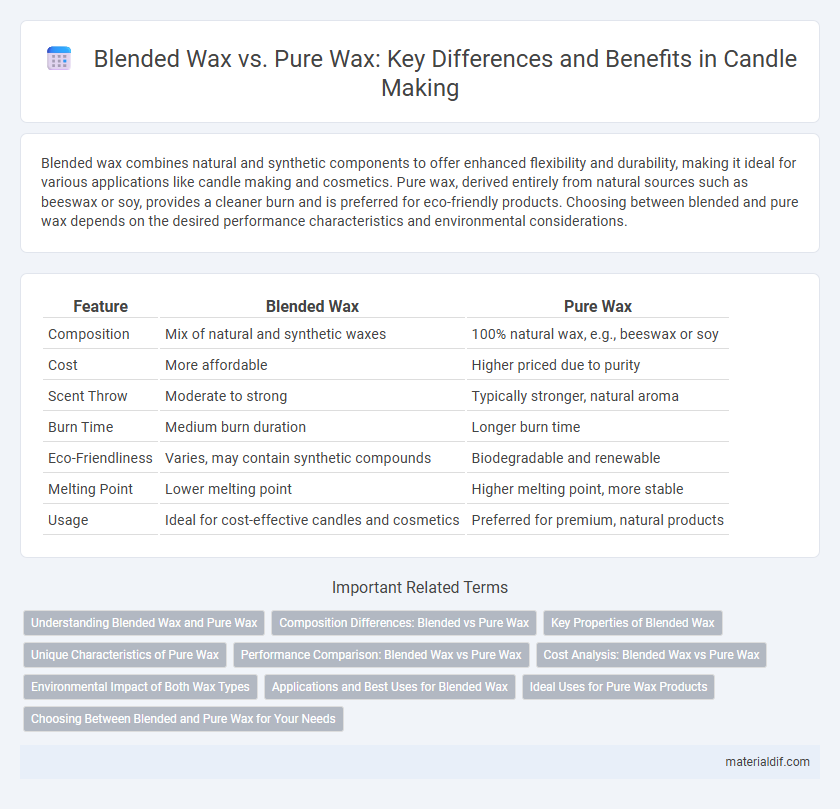Blended wax combines natural and synthetic components to offer enhanced flexibility and durability, making it ideal for various applications like candle making and cosmetics. Pure wax, derived entirely from natural sources such as beeswax or soy, provides a cleaner burn and is preferred for eco-friendly products. Choosing between blended and pure wax depends on the desired performance characteristics and environmental considerations.
Table of Comparison
| Feature | Blended Wax | Pure Wax |
|---|---|---|
| Composition | Mix of natural and synthetic waxes | 100% natural wax, e.g., beeswax or soy |
| Cost | More affordable | Higher priced due to purity |
| Scent Throw | Moderate to strong | Typically stronger, natural aroma |
| Burn Time | Medium burn duration | Longer burn time |
| Eco-Friendliness | Varies, may contain synthetic compounds | Biodegradable and renewable |
| Melting Point | Lower melting point | Higher melting point, more stable |
| Usage | Ideal for cost-effective candles and cosmetics | Preferred for premium, natural products |
Understanding Blended Wax and Pure Wax
Blended wax combines natural and synthetic waxes to enhance performance characteristics such as melting point, texture, and burn time, making it popular for candles and cosmetics. Pure wax, derived from a single natural source like beeswax or soy, offers consistent chemical composition and biodegradability but may have limitations in texture flexibility and melting range. Understanding the differences in composition and properties helps in selecting the right wax type for specific applications like candle making, skincare, or industrial uses.
Composition Differences: Blended vs Pure Wax
Blended wax combines natural and synthetic components, offering a mix of paraffin, soy, or beeswax with additives like polymers to enhance durability and scent retention. Pure wax consists entirely of a single substance, such as 100% beeswax or soy wax, providing a clean burn and natural fragrance but typically less flexibility in texture and melting point. The composition differences impact burning time, scent throw, and environmental footprint, making pure wax more eco-friendly while blended wax delivers enhanced performance.
Key Properties of Blended Wax
Blended wax combines natural and synthetic components to optimize hardness, melting point, and scent throw, making it more versatile than pure wax. Its improved burn time and consistency provide a balanced performance ideal for candle making and cosmetics. Blended waxes often enhance scent retention and reduce cracking, delivering a smoother finish.
Unique Characteristics of Pure Wax
Pure wax, derived directly from natural sources like beeswax or soy, boasts a higher purity level without additives, resulting in a cleaner burn and stronger fragrance throw. Its unique chemical composition offers increased melting points and enhanced texture, providing superior durability and a smooth finish. Unlike blended waxes, pure wax maintains consistent quality, making it ideal for eco-friendly and health-conscious candle production.
Performance Comparison: Blended Wax vs Pure Wax
Blended wax combines natural and synthetic components, offering enhanced flexibility, durability, and melt point consistency compared to pure wax, which is typically more brittle and less adaptable to temperature variations. Pure wax provides a cleaner burn with fewer additives but may lack the longevity and smooth texture delivered by blended formulations in candle making and cosmetic applications. Performance metrics such as burn time, scent throw, and texture smoothness generally favor blended wax for versatility and cost-effectiveness in commercial use.
Cost Analysis: Blended Wax vs Pure Wax
Blended wax typically costs less than pure wax due to the combination of different waxes and additives, reducing overall production expenses. Pure wax, such as 100% beeswax or soy wax, commands a higher price because of its natural composition and higher purity. The cost-effectiveness of blended wax makes it a popular choice for large-scale candle manufacturing where budget constraints are critical.
Environmental Impact of Both Wax Types
Blended wax, often composed of paraffin combined with natural waxes, typically results in higher carbon emissions and slower biodegradability compared to pure wax varieties like soy or beeswax, which are derived from renewable resources and break down more efficiently. Pure waxes generally have a lower environmental footprint due to sustainable sourcing and minimal chemical processing, reducing soil and air pollution. The environmental impact of wax types directly influences their life cycle assessments, making pure waxes a preferable choice for eco-friendly applications.
Applications and Best Uses for Blended Wax
Blended wax combines natural and synthetic components, offering enhanced durability and flexibility ideal for candle-making, cosmetics, and industrial coatings. Its adjustable melting point and improved texture make it suitable for applications requiring consistent performance and affordability. Compared to pure wax, blended wax excels in mass production and products needing extended shelf life or specific mechanical properties.
Ideal Uses for Pure Wax Products
Pure wax products, such as beeswax or soy wax, are ideal for applications requiring natural aroma and clean burning, making them perfect for candle making, cosmetics, and skincare formulations. Their unaltered composition ensures minimal additives, enhancing purity and hypoallergenic properties suitable for sensitive skin and eco-friendly projects. Pure wax also excels in crafts and food preservation, providing a biodegradable and sustainable option compared to blended waxes.
Choosing Between Blended and Pure Wax for Your Needs
Blended wax combines natural and synthetic components to offer improved durability and melting performance, making it ideal for budget-conscious consumers seeking versatility. Pure wax, made solely from natural sources like beeswax or soy, provides superior fragrance retention and a cleaner burn preferred by eco-conscious users. Selecting between blended and pure wax hinges on your priorities for cost, scent throw, and environmental impact.
Blended wax vs Pure wax Infographic

 materialdif.com
materialdif.com